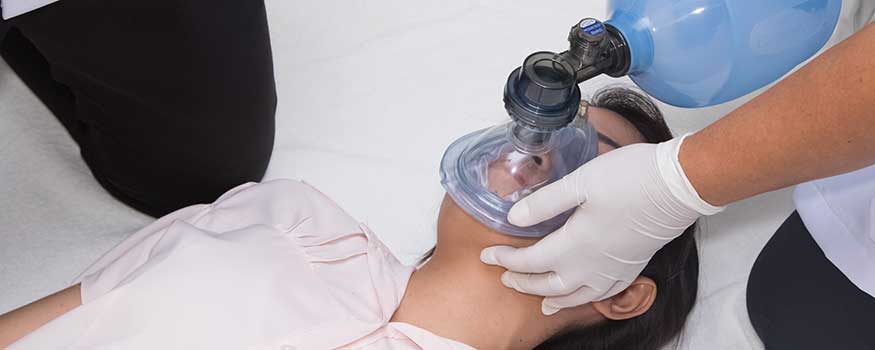Jackson Price, a 14-year-old white male, is admitted to the emergency department with an asthma attack. After receiving albuterol 2.5 mg by nebulizer and methylprednisolone 40 mg I.V, his forced expiratory volume in 1 second (FEV1) rises from 20% to 30%, indicating a favorable response. During handoff to the medical unit, Brennan, the medical-unit nurse, learns Jackson returned home yesterday from a 2-day camping trip, where he’d caught a cold.
History and assessment hints
Brennan finds Jackson oriented and cooperative. He obtains the following vital signs: pulse 110 beats/minute (bpm), respiratory rate (RR) 20 breaths/minute, blood pressure (BP) 138/76 mm Hg, and oxygen saturation (O2 sat) 93% on 2 L oxygen by nasal cannula. On chest auscultation, he hears expiratory wheezes throughout.
Jackson’s FEV1 has decreased to 20%. Brennan notifies the physician, who prescribes another dose of albuterol 2.5 mg by nebulizer and adds ipratropium bromide 0.5 mg. As ordered, Brennan gives additional doses of both drugs every 20 minutes, for a total of three doses each.
He continues to observe Jackson’s respiratory effort and monitor for adverse effects of albuterol and ipratropium, such as tremors, tachycardia, and hypokalemia. Not relying on pulse oximetry to assess respiratory status, he checks the respiratory rate for a full minute. He also stays alert for arrhythmias related to hypoxia and electrolyte imbalances.
Four hours later, Brennan records these vital signs: pulse 123 bpm, RR 20 breaths/minute, BP 147/82 mm Hg, O2 sat 91% on 2 L oxygen, and temperature 98.6° F (37° C). Jackson now complains of worsening shortness of breath. Brennan increases the oxygen flow to 50% by face mask, pages the resident, and activates the rapid response team (RRT).
On the scene
The RRT finds Jackson sitting in a tripod position, appearing anxious as he receives albuterol by continuous nebulizer. His RR is 42 breaths/minute, with retractions and tracheal tugging. Bilateral breath sounds are quiet, with no wheezing and minimal air movement. Using pursed-lip breathing, Jackson answers the resident’s questions with short phrases, unable to utter full sentences. He says he has been feeling breathless for an hour and is very tired. Arterial blood gas (ABG) results on 50% oxygen are: pH 7.30, partial pressure of carbon dioxide (Paco2) 56 mm Hg, partial pressure of oxygen (PaO2) 74 mm Hg, bicarbonate (HCO3-) 24 mEq/L, and O2 sat 93%.
Jackson is transferred to the intensive care unit (ICU) for noninvasive positive-pressure ventilation. Despite ongoing support, he continues to tire, eventually requiring intubation. To prevent complications of ventilator-induced hyperventilation, caregivers limit ventilator settings, allowing for moderate hypercarbia with associated respiratory acidosis. They give steroids to avoid a second asthma exacerbation.
Outcome
On the third day after ICU admission, Jackson is successfully extubated. His post-extubation vital signs are: pulse 77 bpm, RR 14 breaths/minute, BP 116/68 mm Hg, O2 sat 98% on room air, and temperature 97.8° F (36.6° C). His ABGs are normal.
Education and follow-up
Signs and symptoms of asthma exacerbation include increased respiratory effort, speaking in words rather than sentences, using pursed-lip breathing, wheezing, agitation, and tachycardia.
Before discharge, Brennan reinforces teaching on the benefits of keeping an asthma diary to record asthma triggers, symptoms, medication use, and FEV1 results. He reviews Jackson’s existing action plan for managing asthma exacerbations, and asks him and his parents for a return demonstration of proper technique for aerosol medication delivery and FEV1 measurement. He also checks Jackson’s immunization record to make sure it’s up-to-date.
Visit www.AmericanNurseToday.com for a complete list of references.
The authors work at Queen’s Medical Center in Honolulu, Hawaii. Kevin Matsumoto and Darcy Day are Clinical Ladder IV staff RNs for the Rapid Response/Crisis RN team. Christy Passion is a Clinical Ladder IV staff RN for the Rapid Response/Crisis RN team and a staff RN in the surgical intensive care unit.


















